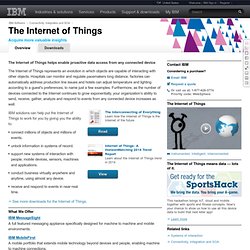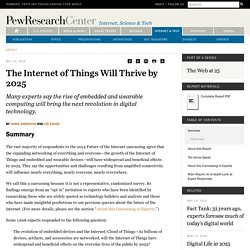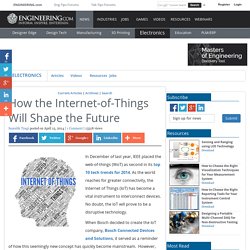

Introducing Web 3.0: Internet of Things. History of the Internet of Things- Postscapes. Welcome to Forbes. Web of Things - Connecting People and Objects on the Web. The Internet of Things - Overview. The Internet of Things helps enable proactive data access from any connected device The Internet of Things represents an evolution in which objects are capable of interacting with other objects.

Hospitals can monitor and regulate pacemakers long distance, factories can automatically address production line issues and hotels can adjust temperature and lighting according to a guest's preferences, to name just a few examples. Furthermore, as the number of devices connected to the Internet continues to grow exponentially, your organization's ability to send, receive, gather, analyze and respond to events from any connected device increases as well. A Web of Things on the Internet of Things. Summary Giving me more apps on my phone and more things to manage doesn't appeal to me.

But giving me a personal network that automates drudgery and enables things that I couldn't do before does. That's the promise of a personal event network and why I think everyone will want one. This article by Marshall Kirkpatrick describes why the Internet of Things is real and happening right before our eyes. The Internet of Things is happening because more and more things are being connected to the 'Net. I like the phrase "Web of Things" because "Internet of Things" has come to describe what is known as "M2M" or machine-to-machine connection.
M2M technologies are being used to create services that back up physical products. Marshall uses the example of a traffic sign: If you've ever driven past one of those big signs on a road that show you your own driving speed, you might have wondered who else was seeing that information. We might view M2M interactions like this: The Internet of Things. In most organizations, information travels along familiar routes.
Proprietary information is lodged in databases and analyzed in reports and then rises up the management chain. Information also originates externally—gathered from public sources, harvested from the Internet, or purchased from information suppliers. But the predictable pathways of information are changing: the physical world itself is becoming a type of information system.
In what’s called the Internet of Things, sensors and actuators embedded in physical objects—from roadways to pacemakers—are linked through wired and wireless networks, often using the same Internet Protocol (IP) that connects the Internet. These networks churn out huge volumes of data that flow to computers for analysis. Pill-shaped microcameras already traverse the human digestive tract and send back thousands of images to pinpoint sources of illness. Podcast When virtual-world capabilities meet real-world businesses Exhibit Enlarge 1. 2. 3. 1. 2. Internet of Things (IoT) Internet of Things. Many experts say the rise of embedded and wearable computing will bring the next revolution in digital technology.

The vast majority of respondents to the 2014 Future of the Internet canvassing agree that the expanding networking of everything and everyone—the growth of the Internet of Things and embedded and wearable devices—will have widespread and beneficial effects by 2025. They say the opportunities and challenges resulting from amplified connectivity will influence nearly everything, nearly everyone, nearly everywhere. We call this a canvassing because it is not a representative, randomized survey.
Its findings emerge from an “opt in” invitation to experts who have been identified by researching those who are widely quoted as technology builders and analysts and those who have made insightful predictions to our previous queries about the future of the internet. (For more details, please see the section “About this Canvassing of Experts.”) Minority view: Not so fast K.G. Internet of Things Consortium. Internet of Things. Are you ready for the Internet of Things?
The Future of IoT. How the Internet-of-Things Will Shape the Future. In December of last year, IEEE placed the web-of-things (WoT) as second in its top 10 tech trends for 2014.

As the world reaches for greater connectivity, the Internet of Things (IoT) has become a vital instrument to interconnect devices. No doubt, the IoT will prove to be a disruptive technology. When Bosch decided to create the IoT company, Bosch Connected Devices and Solutions, it served as a reminder of how this seemingly new concept has quickly become mainstream. However, despite countless media mentions on IoT, understanding remains limited with many of us never experiencing it firsthand. What is the Internet of Things? Companies like Samsung and GE are manufacturing products like smart thermostats, lighting systems and other appliances that communicate using the IoT.